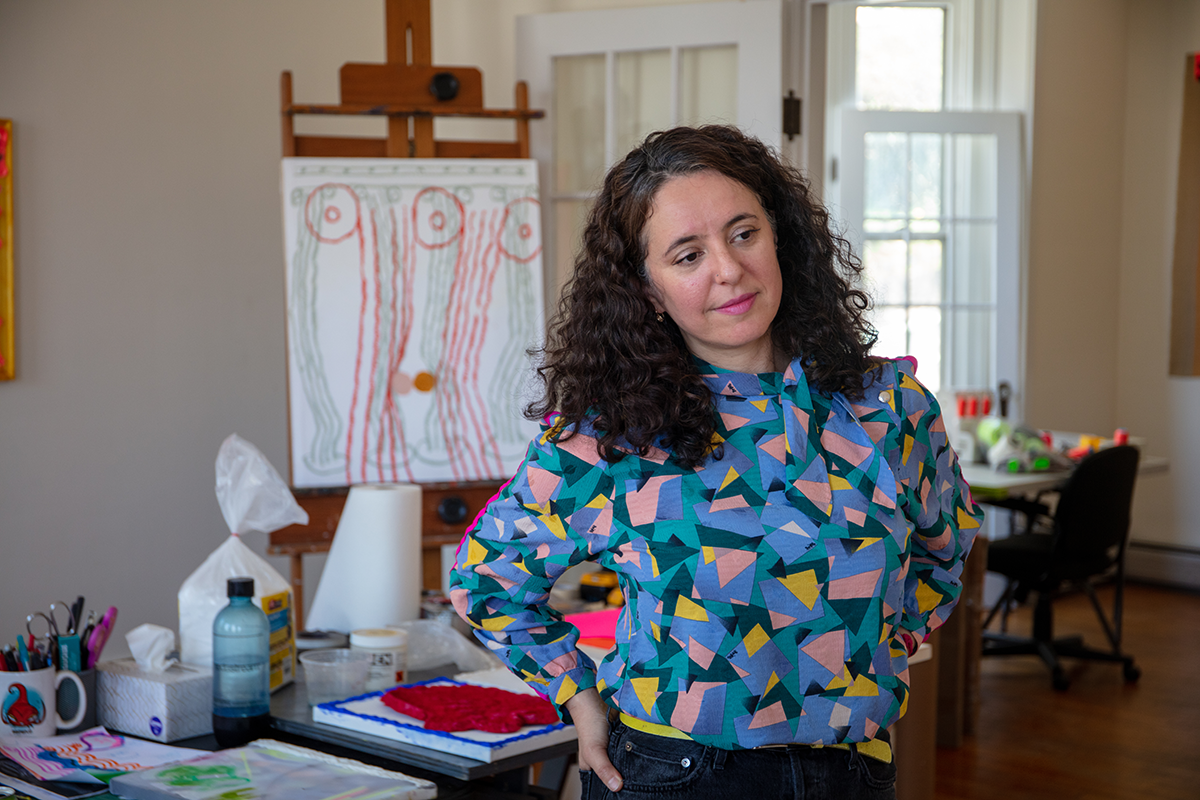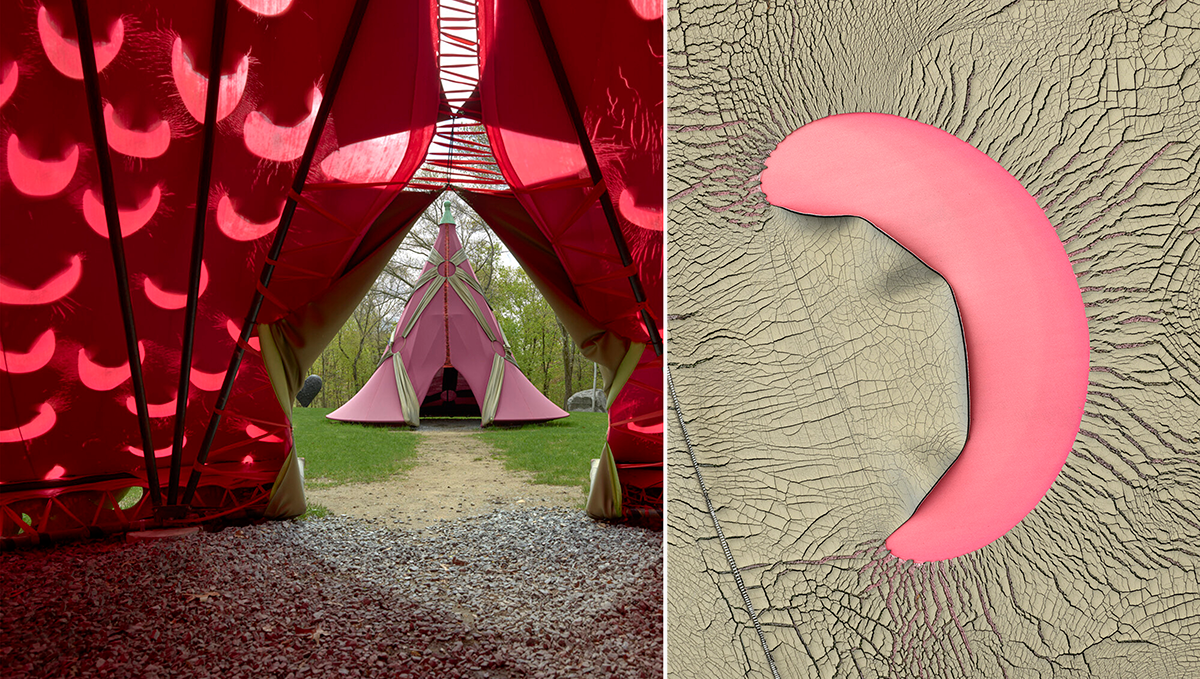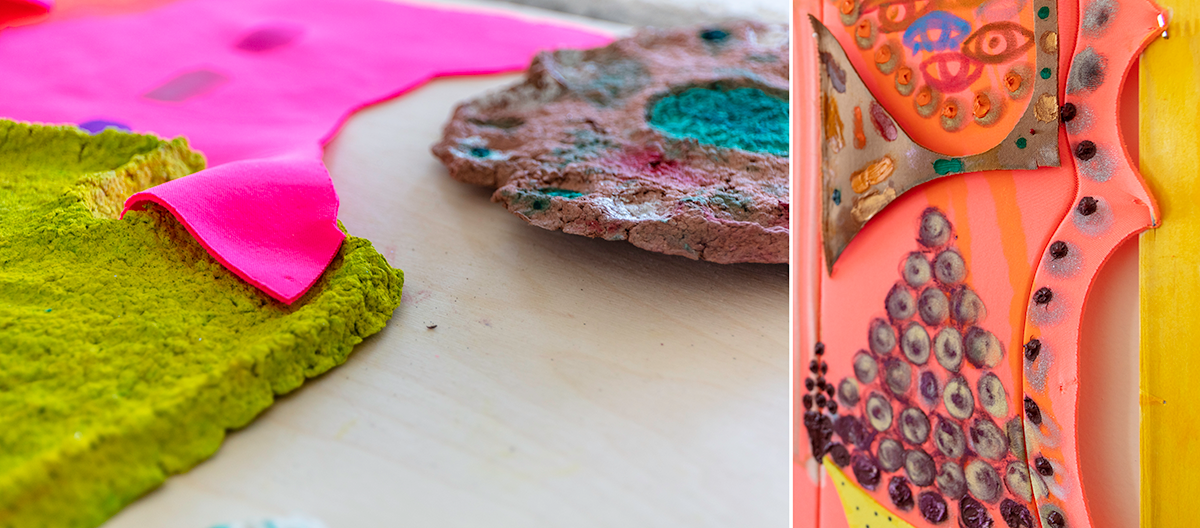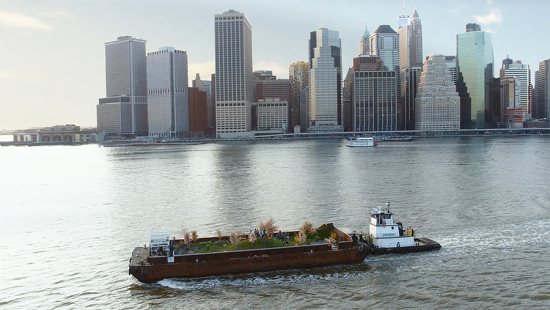Perspective in Tension: Explorations with Leeza Meksin
Assistant Professor of Art Leeza Meksin invites us into her studio to explore the intersection of gender, architecture, garments, and painting in her colorful and highly textured work.

Whether she is dressing buildings in spandex, creating false doors that double and mimic the doors in the room, or installing elaborate tents outside on the lawn, there is a tension that breeds insight in Leeza Meksin's artistic output. Impermanence challenges posterity, feminine and masculine stereotypes lock horns, and the viewer is invited to explore how our human bodies and the materials we shelter them in — whether that's the fabric or the brick and mortar wrapped around us — shape our perspectives.
Meksin, who joined the Department of Art faculty as an assistant professor in July 2021 and will take on the role of Director of Graduate Studies in art on July 1, 2022, welcomed us into her studio, where the bold color in the surrounding work electrified the energy in the room. While the themes she tackles carry significant weight, her approach is infused with a spirit of experimentation and playfulness as materials challenge the status quo of high and low brow art contexts and taste.
1
A major medium in your work is fabric, which brings a whole host of interesting color, texture, and shape possibilities to the table, as well as some ingrained cultural ideas about gender and the body. What initially drew you to these materials and how has that relationship evolved?
I was drawn to fabric as a child, making collages from scraps of fabric we had in the house, and also taking classes at a local afterschool program where I learned how to make fabric flowers using heat shaping tools to create petals and leaves. In high school, I continued to make collage using felt and also experimented with making my own clothes. In college, I designed costumes for the university theater, working on large-scale productions with many characters and costume changes. This is when I started to think about fabric's relationship to the body and the paradox in how a garment reveals something about the person wearing it by concealing their body. Later, in grad school, I sought to integrate fabric into my painting practice while drawing attention to the fact that fabric has been a big part of the painterly tradition — a fact that is often neutralized or overlooked. I wanted to insert the concerns of a gendered body into painting itself — to make paintings wear outfits and be less rectilinear, less rigid. This thinking led me to ask questions about the parallels and contradictions between the conventions of architecture, painting, and clothing, eventually leading me to make what I call "architectural drag" and "outfits for buildings."

2
Your work, perhaps most dramatically in your Turret Tops installation at the deCordova Sculpture Park and Museum, has allowed you to push on the tension between art that is transient and art that is intended for posterity. The work was installed on the lawn for a limited time, but additionally its materials, which included neoprene, glideskin, and ribbon, were exposed to the Lincoln, Massachusetts, weather and degraded over time. Is that impermanence and erasure attractive to you, or does it cause anxiety?
It both attracts and interests me while causing a lot of anxiety. There was something new to see and discover all the time during the 14 months that Turret Tops existed on the grounds of the park. I love that I got to learn and grow from them even after being "done" with installing the project. The erasure in itself is implicit in site-specific temporary installation, which connects in interesting ways to gender roles and emotional labor.
3
There are many notable points of intersection with architecture across your portfolio, from dressing buildings in spandex "outfits" as you have referred to them to exploring architectural features such as turrets and doors and columns. What interests you about this dialog?
I’m interested in the gendered qualities of both architecture and clothing, the way architecture seems to lend itself to masculine and straight descriptors and garments lean more to the feminine and the queer. There's a long history of gendered labor divides that fuels these false binaries — my work reflects on these inherited and often tacit beliefs, and asks questions such as: How can architecture be less straight and less domineering? Can buildings be queer? Could sewing or embroidery be considered as serious civic pursuits?
The types of dwellings we build for ourselves (or accept as being built for us) reflect our values as a culture in a similar way that clothing reflects our individual preferences as well as cultural norms and fads. It may seem that we choose our outfits, but when it comes to architecture it's often chosen for us, and yet it constantly shapes who we are. How is our urban sensibility different from that of people who lived in caves or yurts or teepees? It's hard to guess, but it appears that putting our bodies in boxes full of straight lines and right angles (qualities antithetical to our bodies) has an alienating effect on how we think of ourselves and likely distances us from accepting our bodies as they are, which, in turn, makes it harder to honor our lived experiences, and perhaps makes us less empathetic and open to the lived experiences of other living things.

4
You're currently putting together a book that's providing you with the opportunity to reflect back on your work to date and take stock of your practice. What's emerging for you from this experience?
First and foremost, there's a feeling of "Wow, I’ve made a lot of work!" Then, there's a more anxious thought: I'm getting old(er); there's a sense of a story, a progression with stages. And then, a sense of satisfaction that I have the opportunity to look back at so many different projects over the course of the last 20 years and see clear conceptual threads despite the great variety of materials and mediums that I work in.

5
How do you then bring your approach to practice and reflections on your work into your teaching? How do the questions and issues you engage with in your own work then shape your guiding principles when it comes to pedagogy and critique of student work as you support them in building a practice of their own?
I value exploration, experimentation, and play in my own practice, and seek to imbue my class ethos and assignments with the same ideals. As far as critique, I aim to find a balance between encouragement and constructive feedback to help students grow and develop. Challenging long-held beliefs about what art should be or could be is at the heart of my approach to fostering rigorous discourse in class.
6
What do you see as the most important thing to understand about links between practice and pedagogy today?
I think this may be different for different types of artists and teachers. For me, my practice helps my teaching and my teaching helps my practice. It's a reciprocal and close-knit relationship in which both activities benefit from the constant cross-pollination. When in my work and research I come across new artists whose work interests me, I often end up showing images of their work in the classes I teach and the response I get from the students helps to shape my own reading of the work. The same is true for books, essays, journal articles, poetry — anything I read that connects to my work and the ideas I'm developing often resurfaces on my syllabi. The more I change up my syllabus, the fresher and more exciting are the connections that my students and I draw together in class. I see myself as a lifelong student and eschew hierarchical posturing when it comes to teaching. I enjoy learning from them, and this two-way street often makes for lifelong friendships after my students graduate.

Stay connected! Follow @cornellaap on Instagram, Facebook, Twitter, and LinkedIn; and subscribe to our AAP bi-weekly newsletter.







